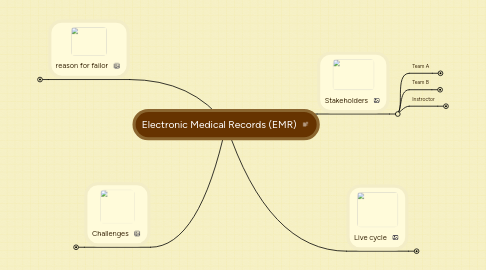
1. Stakeholders
1.1. Team A
1.1.1. Hospital Director
1.1.2. Head of department
1.1.3. IT Directors
1.1.4. Head of Nurse
1.1.5. Reception
1.1.6. Lab
1.1.7. Radiology
1.1.8. Hardwared
1.1.9. Patient
1.2. Team B
1.2.1. Administration
1.2.2. BOD
1.2.3. HR
1.2.4. Nurses
1.2.5. Doctors
1.2.6. Labs
1.2.7. Pharmacy
1.2.8. Gov
1.2.9. Patients
1.2.10. Communities
1.2.11. Police
1.2.12. Layers
1.2.13. Insurance
1.2.14. Vendors
1.2.15. Eng.
1.2.16. Potential cust New
1.2.17. Trainers
1.2.18. Infents
1.3. Instroctor
1.3.1. Infection control
1.3.2. Archive Dept.
1.3.3. Management not Director
1.3.4. IT ambisouce
1.3.5. Labs
1.3.6. Hardware suppliers
1.3.7. Finance
1.3.8. Pharmacy
1.3.9. Doctors
2. Live cycle
2.1. Need assessment
2.2. Requirement Gathering
2.2.1. Unique Key = Civil ID
2.2.2. Helth History
2.2.3. Number of users
2.2.4. permission level
2.2.5. number of concurent users to the data
2.2.6. Storage space needed
2.2.7. integrate with current systems
2.2.8. Team A
2.2.8.1. Supp Windows
2.2.8.1.1. Web based
2.2.8.2. SQL
2.2.8.2.1. functionality not architecture
2.2.8.3. Alert forums
2.2.8.4. Timeline view
2.2.8.5. HL7 compliant
2.2.8.5.1. ASMT
2.2.8.6. ICD9/10
2.2.8.7. e forum
2.2.9. Team B
2.2.9.1. integration
2.2.9.2. upgrade update system
2.2.9.2.1. for license must be price garentee for say 5 years
2.2.9.3. number of facilities
2.2.9.4. number of patients
2.2.9.5. e-forms
2.2.9.6. backup
2.2.9.6.1. desaster recovery
2.2.9.6.2. desaster plan
2.2.9.7. downtime
2.2.9.8. time
2.2.9.9. maintenance
2.2.9.10. support
2.2.9.11. access level
2.2.9.12. training
2.2.9.13. localization
2.2.9.14. document capturing
2.3. Review and approval
2.4. Request for Information (RFI)
2.4.1. Ask the vendor to give plan proposal with budget
2.4.2. ask for functions
2.4.3. ask for availability
2.4.4. ask about technology
2.5. Request for Proposal (RFP)
2.6. Analysis
2.6.1. Functionality
2.6.1.1. categories
2.6.1.1.1. must
2.6.1.1.2. optional

